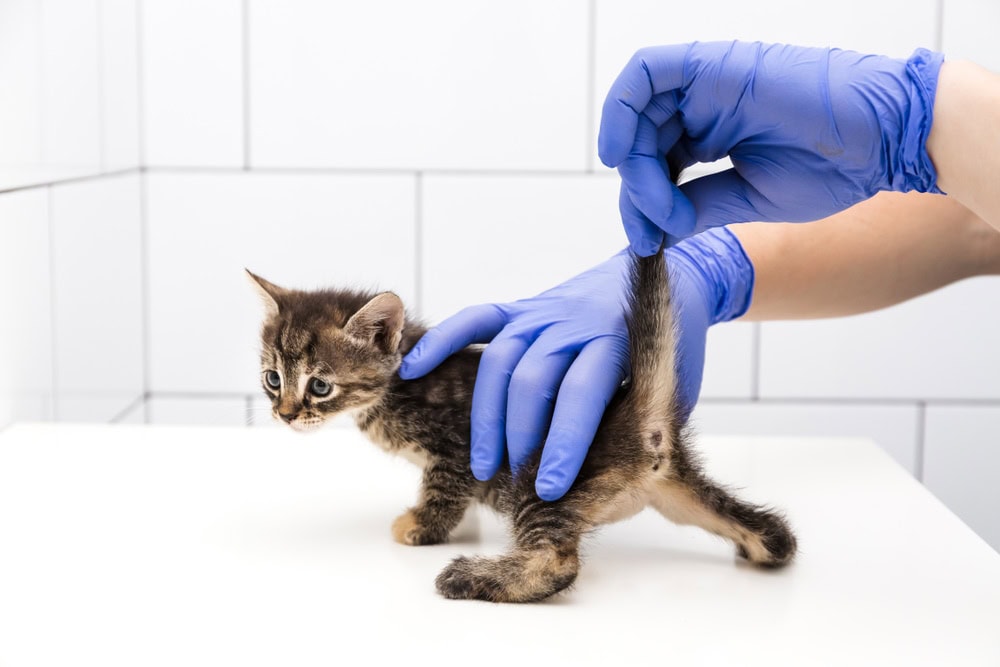Determining the sex of a cat isn’t as easy as it is with dogs. How many stories have you heard in which a cat named “Jack” turns out to be a “Jill?” This is an incredibly common situation, and it shows how foreign the feline genitalia is to most humans. However, when it comes to the basics, cats have the same basic anatomy as humans; male cats are born with testes and a penis, and female cats are born with a clitoris and vagina.
So, why is it such a challenge to determine a cat’s sex? In this article, we will discuss how you can figure out your cat’s sex, as well as why the information is important, beyond choosing the perfect name for your pet.

The Purpose and Function of a Cat’s Clitoris
All mammalian embryos essentially start out life as female (which is why males have nipples!). Shortly into development, their genetics determine whether their gonads will become ovaries or testes, and if they will have a penis or clitoris. That’s right, the clitoris is the female equivalent of the penis.
In female humans, ovulation occurs on a regular cycle. As for female cats, they only ovulate when they mate with a male. This is known as induced ovulation, in which the physical act of copulation causes the ovaries to release eggs. Since female cats reproduce through induced ovulation, there must be a biological “tripwire” of sorts to tell the ovaries when to release eggs, and this “tripwire” is widely believed to be the clitoris. The feline penis is covered in tiny barbs that result in even more friction and stimulation during copulation.
In humans, the clitoris is located a distance away from the vagina. For female cats, the clitoris is located inside the vestibule, making it ideally positioned for stimulation during mating.
As clitoral stimulation is a natural occurrence during feline breeding, it is believed that the clitoris acts as a trigger, prompting the release of hormones that will set off ovulation. Therefore, the clitoris plays a key role in feline reproduction and breeding.


How to Determine the Sex of Your Cat
While determining your cat’s sex can be difficult, it’s not impossible. The easiest way to discover the sex of your cat is to take them to the vet for an official examination. Otherwise, there are different methods you can use depending on your cat’s age.
Unlike with dogs, the feline penis is not located on the abdomen. Instead, it is hidden from view, tucked underneath the anus. Apart from when they are having a thorough clean, you will generally not catch sight of your cat’s penis.
Under 8 Weeks of Age
If your kitten is less than 8 weeks old, determining their sex will be a bit more of a challenge. Like the rest of your kitten’s body, their external genitalia is tiny and difficult to see.
To make sexing your kitten easier, it is ideal if you can compare them to their littermates. This will allow you to see examples of male and female kittens so that you can more easily differentiate between the two.
If your kitten is no longer with their littermates, you can attempt to determine their sex the same way you would for a kitten over eight weeks of age.
Over 8 Weeks of Age
For cats over 8 weeks old, determining their sex is much more straightforward. Simply lift their tail and check the shape of the genital opening as well as the distance between the opening and the anus.
In males, the genital opening will be circular and farther away from the anus. In females, the genital opening will be linear and closer to the anus.
As most cat owners know, randomly grabbing your cat’s tail and lifting it is unlikely to yield good results. Instead, approach the situation carefully so that your cat feels comfortable. First, find a time when your cat is calm and gently hold them in your lap.
Once they are relaxed, you can gently lift their tail to inspect them. It is important to note that you will likely not be able to see your cat’s penis, so determining your cat’s sex based on that structure alone is not advised.
The same goes for the testes, which may have already been removed if your cat has been sterilized. Therefore, a lack of visible male sex structures does not necessarily mean your cat is female.


Are There Other Ways to Determine the Sex of Your Cat?
The only way to guarantee the sex of your cat is to examine their genitals. If you are struggling to do so, your vet can determine your cat’s sex for you. In the meantime, there may be some other ways to get an idea of the sex of your cat.
Unique to felines, the gene for the orange coat color is sex-linked, found only on the X-chromosome. Males with this gene will be either black or orange (ginger), with or without some white. Females, however, can be black, ginger, or a blend (calico or tortoiseshell). This means that virtually all calico or tortoiseshell cats are female, and around 80{a47be734f0df8d7f120a7df290cf380c79376e8356d1aab405383bb23aa6ce67} of ginger cats are male.
However, this method is not a guarantee. While incredibly rare, male calico cats exist. Due to genetic mutations that cause cats to have more than two sex chromosomes, male cats can develop calico colors. These cats are known as Klinefelter cats.


Why Is It Important to Know the Sex of Your Cat?
Many people may think that knowing your cat’s sex is only important for naming purposes, but that’s not the case. There are several reasons that pet owners should know their pet’s sex. Some health issues or behavioral problems are more prevalent in one sex over another.
For instance, males are at higher risk of fatal urinary tract blockages than females. Knowing which conditions your cat may be susceptible to based on their sex can allow you to catch the signs of a condition earlier and potentially save your cat a lot of discomfort and pain.
If you have a brother and sister, or just a male and female kitten, you will want to know this so you can make plans for neutering before ending up with unwanted kittens, especially from siblings!
In addition, sexual development disorders can be an issue, such as gonadal disorders. Gonadal disorders impact your cat’s reproductive organs, but the signs may appear different based on your cat’s sex. For example, in females, common signs of a sexual development disorder include an abnormally large clitoris.
Therefore, knowing your cat’s sex tells you not just if they are a “Jack” or a “Jill,” but it also helps you to remain informed on their health status.


Final Thoughts
The female cat does indeed have a clitoris, and it likely plays a vital role in feline reproduction. As induced ovulators, it is important for copulation to stimulate a hormonal response in order for eggs to be released from the ovaries. The location of the clitoris, along with the anatomy of the penis, ensures this stimulation occurs.
While female cats have clitorises, this won’t help you to determine a cat’s sex. Instead, focus on the shape of the genital opening as well as its distance from the anus. If you are confused, consulting your vet is the best way to go.
Featured Image Credit: Hanna Taniukevich, Shutterstock




